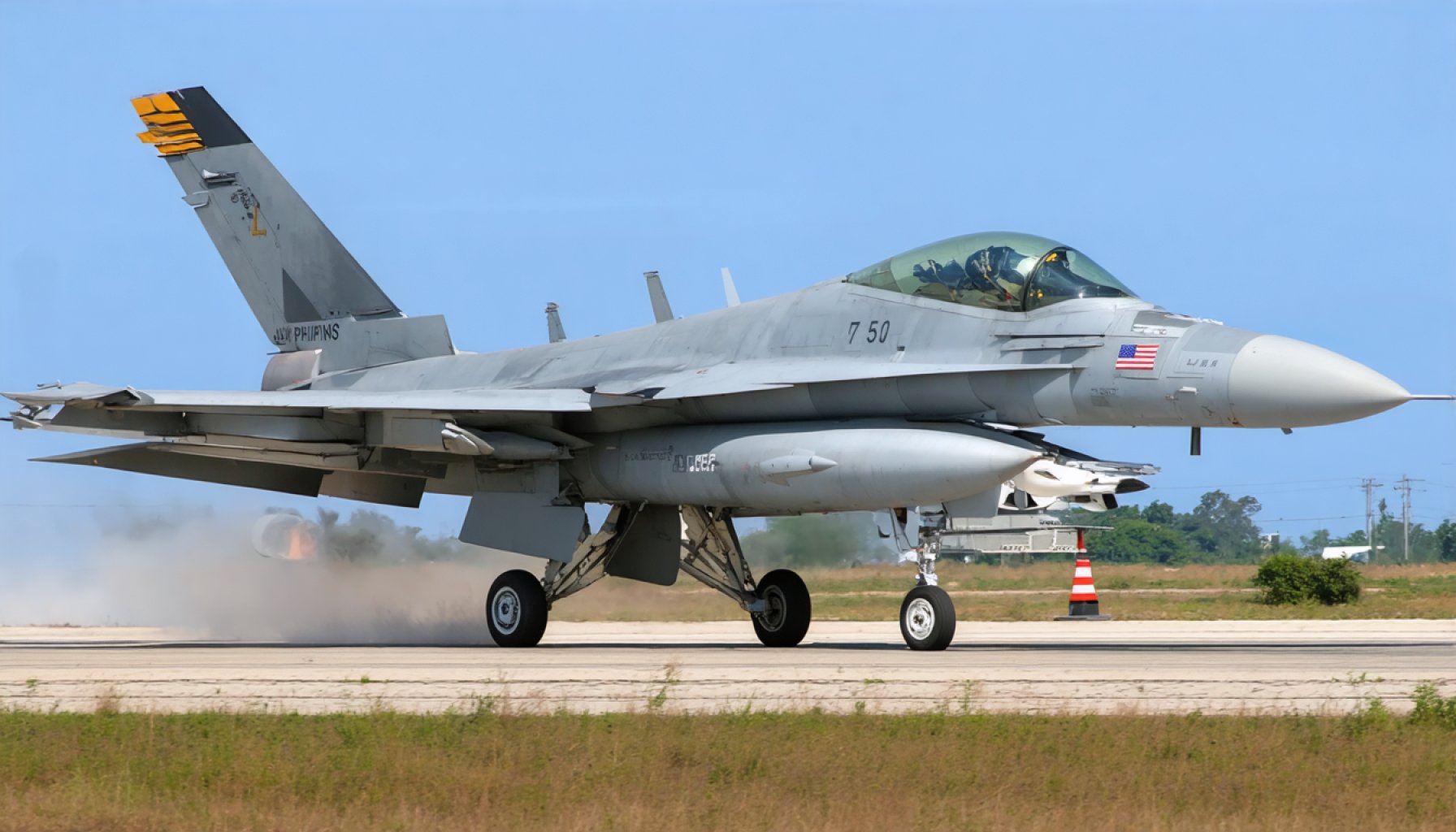- The US has solidified a significant $5.5 billion defense deal with the Philippines, involving the sale of 20 F-16 fighter jets.
- This agreement reinforces US-Philippines strategic ties amid growing tensions with China over the South China Sea.
- The F-16s will enhance the Philippines’ defense capabilities, particularly in monitoring maritime borders.
- The deal symbolizes a broader strategy to maintain regional stability and deter unilateral actions by China.
- US officials emphasize a renewed commitment to the alliance and the strategic importance of the Southeast Asian region.
- This move underscores the balance of power, aiming for regional peace and economic growth through strengthened alliances.
As the sun climbs over Basa Air Base, the silhouette of a US Air Force F-16 fighter jet pierces the morning haze, an emblem of a pivotal juncture in geopolitics. With a swift stride, a Philippine Air Force personnel weaves past these symbols of strengthened alliances, just as the United States solidifies a commitment to its Southeast Asian ally with a staggering $5.5 billion deal.
Against the backdrop of intricate rivalries and mounting tensions with China, this transaction isn’t just about the exchange of state-of-the-art machinery. It’s a bold statement of shared interests and strategic foresight. The US State Department, affirming the significance of this alliance, has green-lit the sale, which encompasses 20 of these elite jets, along with an arsenal of related accoutrements, to the Philippines. Not just a fellow nation, but a treaty-ensured partner in the unyielding quest for stability in a region rife with historic contentions.
These F-16s, capable of agile maneuvers and formidable firepower, promise to elevate the Philippines’ ability to monitor its expansive maritime borders and fortify defenses, an urgent need given the volatile climate in the South China Sea. As Beijing lays aggressive claims to nearly the entire sea—a critical artery of international trade—the Philippines stands its ground bolstered by new might from across the Pacific.
In the corridors of global politics, alliances are reaffirmed. On his visit to Manila, Defense Secretary Pete Hegseth articulated a renewal of deterrence strategies against a backdrop of unyielding challenges from a powerful rival. Not far behind, Secretary of State Marco Rubio pronounced the enduring US commitment to the Philippines in words that contrast vivid past narratives critiquing alliances.
The sale of F-16s thus becomes more than a defense transaction; it is a strategic recalibration in a theater where the stakes are measured not only in territorial terms but in the broader scheme of regional peace and economic progression. As these fighter jets become integral elements of Philippine defense, the urgency of unified global positioning against unilateral assertiveness gains wings—and with it, a renewed assurance for stability in Southeast Asia.
In a climate where tensions threaten to reshape regional order, this move signals a clarion call for balance of power and a renewed assertion of alliances predicated not merely on might, but on a shared vision for peace and prosperity.
The $5.5 Billion Fighter Jet Deal: What It Means for Southeast Asia and Global Stability
Strengthened Alliances and Strategic Insights
The recent agreement between the United States and the Philippines for the sale of 20 cutting-edge F-16 fighter jets underscores a complex geopolitical landscape characterized by heightened tensions and strategic recalibrations. The $5.5 billion deal is noteworthy not only for its scale but for its implications in fostering defense capabilities and alliances in Southeast Asia, particularly amid escalating tensions with China over the South China Sea.
Capabilities and Strategic Advancements
The F-16 fighter jets acquired by the Philippines are renowned for their versatility and state-of-the-art technology. Capable of executing agile maneuvers and equipped with advanced avionics and weaponry, these aircraft significantly enhance the Philippines’ defense capacity. This bolsters their ability to monitor maritime regions, vital for safeguarding territorial integrity and protecting critical trade routes.
How the F-16s will impact Defense Readiness
1. Enhanced Surveillance: With the capacity for rapid response and long-range capabilities, these jets improve maritime and aerial surveillance, allowing for better monitoring of disputed regions.
2. Increased Deterrence: The presence of advanced fighter jets serves as a deterrent against potential aggressors, reinforcing the country’s defense posture.
3. Improved Training and Military Tactics: Integrating these jets requires substantial upgrades in pilot training and military strategies, fostering more sophisticated defense operations.
Industry Trends and Market Forecasts
– Growing Defense Expenditures: Southeast Asian nations are expected to continue increasing defense budgets in response to regional volatility, positioning themselves strongly amid emerging threats.
– ASEAN Dynamics: The Association of Southeast Asian Nations (ASEAN) could see shifts in internal dynamics as member states assess their geopolitical strategies in light of this US-Philippine deal.
Security and Geopolitical Implications
– Balancing China’s Influence: The acquisition of these jets underscores efforts to maintain a balance of power in the region. By leaning on US alliances, the Philippines sends a clear message about its stance against unilateral territorial claims by China.
– Strengthening Multinational Ties: This deal may encourage other nations to reassess and potentially solidify their defense relations with global powers, particularly concerning maritime security.
Actionable Recommendations
– Strategic Defense Assessment: Other Southeast Asian countries should evaluate their defense infrastructure and consider similar upgrades or alliances to bolster security.
– Diplomatic Engagements: Maintaining open dialogue with major powers can ensure geopolitical interests are aligned with regional peace and economic progress.
– Invest in Technology and Training: Nations should invest in technological advancements and military training to leverage the full potential of new defense acquisitions.
For more insights into global defense innovations and strategic enhancements, visit the official site of the US Department of Defense. As these developments unfold, stay informed about the shifting dynamics in the Asia-Pacific region and beyond.











